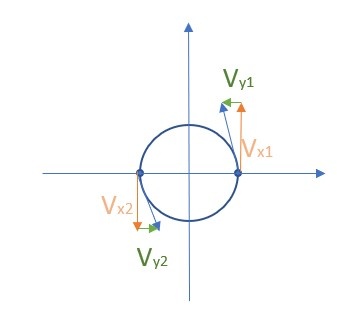

You find the source code for our examples in the software-folder:
cd ~\dev\software\basic_circle_example\src
cd ~\dev\software\hlc\matlab\basic_circle_example
In this example one vehicle drives in a circle which is not attached to the map. See the sourcecode for explicit documentation. This chapter only provides the theoretical background.
At first a DDS Writer for the RTI DDS Service is intialtized to ensure that position and speed will be sent to the simulation and the vehicle.
Next points and speed of the vehicle are defined at each point for the entire trajectory. When you use v_x and v_y keep in mind that this is not the actual speed but the speed vector at your current location (remember that vges = sqrt(vx^2 +vy^2) as it is a vector). You use this vector to define the direction for your vehicle, so where it has to steer next:
 |  |
|---|
While defining the speed vector also be aware that the tangent will fit with the vector/tangent from the previous point and that the shape of the curve is not only affected by the vector of the starting point but also of the vector at the end point/next starting point. It turns out that it is the easiest way to define your speed vector by drawing our shape first and define the signs of your vectors to ensure the right orientations. It is recommanded to always define a speed for both v_x and v_y, even if it is a small value, to ensure the right orientation of your vehicle. Last but not least remember that your are giving a trajectory to a physical system so sharp edges won't be possible.
The speed is given in m/s.
For the segment duration keep in mind that speed, time and waylength have to fit. Verify your speed/way/duration with vges =ssegment/tsegmentduration.
All data are sent to the vehicle using the writer-function from the beginning.
hlc_" + vehicle_id, where the latter is the ID of the vehicle the HLC is responsible for